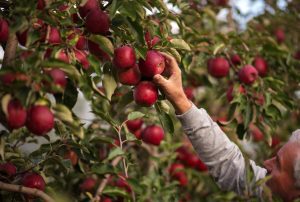Storing apples
Industry Best PracticeOne of the great natural features of apples is that they store really well. In Australia you can buy crisp and tasty apples all year around because of how apples are stored.
Apple storage in history
Historically, one of the reasons apples have become such an important and loved fruit is because they can be kept for long periods of time before consumption.
In Europe, it was typical to keep apples in the cellar over winter where it was cool and dry so apples could be eaten all year around. Under these conditions they would retain much of their texture and flavour and not rot.
With a modern understanding of how fruit ripens we can improve upon these traditional practices and knowledge to keep our fruit perfectly ripe and ready to eat all year round.
Apple picking and storage
Apple and pear trees produce one crop per year with picking times ranging from January through to May for apples and January through to April for pears – depending on variety.
Australian growers store fruit once it’s picked to ensure they maintain maximum sweetness and crispness. Once picked, it is very important to get fruit out of the heat quickly so it doesn’t over-ripen. This ensures consumers get a perfectly ripe piece of fruit when they come to buy and eat it.
Apple and pear storage facilities in Australia provide an environment where fruit can ‘rest’ until required. Oxygen, carbon dioxide, temperature and humidity are regulated during storage so fruit can go to ‘sleep’ to stop or slow down the aging process.
This enables the industry to provide quality fruit to consumers, year round.
With some apples, like Pink Lady™ apples, the flavour can even improve after a few months storage because the natural acid composition changes, making them slightly sweeter.
Apple storage in Australia
Storage facilities resemble big refrigerators or cool rooms. Each individual room can be monitored depending on the type of storage control used and the variety of fruit housed there. Many types of fruit are kept in storage before consumption to keep them in good condition, including apples and pears.
There are three ways growers store apples in Australia: Cold Storage or regular atmosphere storage (RA); Controlled atmosphere storage (CA); and Smartfresh™.
Cold storage
Cold storage, also known as regular atmosphere (RA) storage, is used to store fruit for short periods of time once it’s picked. Bins of picked fruit come in from the orchard and are put straight into the cool room to maintain fruit temperature at approximately 1˚C, and humidity around 85 per cent.
Controlled atmosphere storage
Controlled atmosphere (CA) storage uses the same temperature and humidity systems as cold storage. It also adjusts the oxygen and carbon dioxide levels in the room to slow the fruit ripening process. Fruit can be stored in controlled atmosphere facilities for a short, medium or long-term period of up to 12 months.
SmartFresh™
SmartFresh is a product that fruit growers can put inside cool rooms, both regular atmosphere and controlled atmosphere, to maintain the ideal conditions to control ripening. SmartFresh contains the ingredient, 1-MCP, which is similar in structure to ethylene – a natural compound that is involved in fruit ripening. When SmartFresh is applied in the cool rooms, it naturally slows the production of ethylene by the fruit until it is taken out of cold storage. Once the fruit is removed from the cold storage, regular ripening continues. SmartFresh biodegrades naturally and there is no residue left in or on the fruit.
SmartFresh also helps to slow down the decline in Vitamin C that starts to occurs after an apple is harvested, therefore helping to maintain better Vitamin C content in apples.

‘Fresh’ apples?
The term ‘fresh’ is used in many different ways to describe fruit.
To some, ‘fresh’ fruit means a piece of fruit that has been picked straight from the trees and eaten very shortly after. To others, a ‘fresh’ piece of fruit is one that has not been processed – for example it is not dried or preserved – and is instead a whole piece of fruit as it is when picked. ‘Fresh’ can also denote the nature or quality of a piece of fruit, so that if an apple is crispy, juicy and tasty, some people would say it is ‘fresh’.
This can be confusing because when one person says ‘fresh’ to describe a piece of fruit – it can mean something very different to another person.
Consumer guide to buying apples
If you want to eat apples when they are in season – then you need to keep an eye out for when different varieties of apples are picked, because that is the time you are most likely to get an apple soon after it is harvested.

If you love eating delicious, crisp and tasty Australian-grown apples all year around then just look for the Aussie Apples sticker on your apples to ensure they are Australian grown. You will be able to buy Aussie Apples any time of the year – although some apples go out of stock because they are so popular and there are none left in storage so you have to wait until the next season!
The best place to keep your apples after you buy them is in the fridge – this keeps them cool so they stay juicy, crisp and fresher for longer.
Compared to other snack foods, apples are very healthy and nutritious and contain no artificial flavours or preservatives. Find out more about Aussie Apples.




